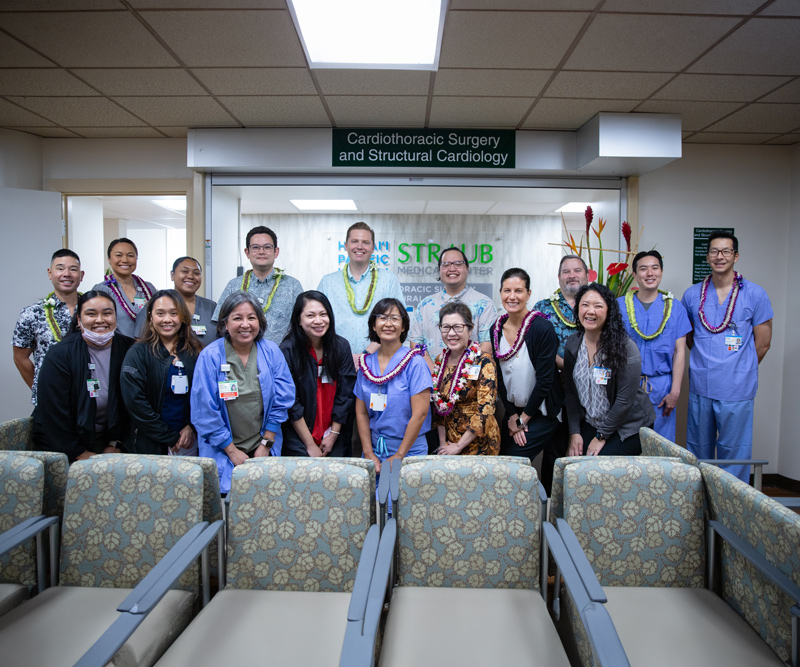
Minimally Invasive Treatment Options for Aortic Valve Stenosis
It's estimated that between 5% and 10% of people aged 70 and older in the United States have a type of heart disease known as severe aortic valve stenosis, according to Dr. Rayji Tsutsui, a Hawaii Pacific Health Medical Group interventional and structural cardiologist based at Straub Benioff Medical Center.
That percentage may be higher in Hawaii because people here tend to live longer, resulting in a larger population of seniors.
Severe aortic valve stenosis occurs when the aortic valve, which is located between the heart and the vessel that carries blood to the vital organs, becomes stiff and narrowed. This results in less blood circulating out of the heart.
The more severe the stenosis, the less the blood circulates.
Some symptoms of aortic valve stenosis are chest discomfort, shortness of breath, lightheadedness and lack of energy.
Very severe symptoms, which may indicate congestive heart failure, include swelling in the legs, difficulty lying flat due to shortness of breath, waking up in the middle of the night gasping for air and losing consciousness.
Tsutsui says severe aortic valve stenosis carries a grave prognosis if it is not treated promptly. The good news is that there is a minimally invasive procedure to replace the diseased valve with a manmade one. It's called transcatheter aortic valve replacement (TAVR), and the Clarence T.C. Ching Heart Center at Straub Benioff Medical Center recently completed its 1,000th TAVR procedure – a milestone not just for the doctors and staff, but for patients as well.
Tsutsui shares more about the disease and TAVR.
What causes aortic valve stenosis?
Risk factors include high blood pressure, high cholesterol, tobacco use, being overweight and increasing age. Advanced kidney disease (being on dialysis) and prior radiation exposure to the area also increase the chance of developing calcium deposits on the aortic valve. These stone-like deposits lead to valve dysfunction.
Younger people can have this condition if they have a hereditary condition. One of the more common is bicuspid aortic valve stenosis. This is present in 1% to 2% of the population, where the aortic valve is made of two leaflets, or parts, rather than the normal three.
How deadly is severe aortic valve stenosis?
Well-established studies have shown that only 50% of patients with severe aortic valve stenosis will live past two years. This is less time than some advanced cancers. The good news, however, is that once the valve is replaced, the outlook for those patients becomes extremely favorable.
What treatments are available?
The only effective treatment for severe aortic valve stenosis is valve replacement. The traditional method is open-heart surgery. However, many elderly patients were unable to undergo that surgery due to the risk associated with their advanced age. TAVR is a minimally invasive procedure that offers as good, if not better in some circumstances, results.
How does TAVR work?
TAVR utilizes catheters to guide a replacement valve through the leg artery to the dysfunctional aortic valve. It is performed under sedation. Most patients are admitted overnight and will be discharged home the next day.
What are the benefits of TAVR?
The beauty is short recovery. It is not uncommon to hear patients who had TAVR say they feel better immediately after the procedure is done. Most patients will need to rest for about a week, then they are back to their usual lives with improved symptoms and will go on to live longer and feel better.
How long have you been a cardiologist?
If you include my training, I have been a cardiologist for 13 years. I completed my training at Cleveland Clinic in Ohio, an institution that has been ranked No. 1 in the United States for cardiology and cardiac surgery for the past 28 years in a row.
Through my education, training and experiences, I became the medical director for cardiovascular quality and outcomes as well as the medical director for our ST-Segment Elevation Marcodial Infraction program at Clarence T.C. Ching Heart Center at Straub Benioff. I feel privileged to work and care for patients in Hawaii.
This article was first featured in the Aug. 28, 2024, issue of MidWeek as a part of the "Dr. in the House" series. See the full publication here.
Published on: August 29, 2024




